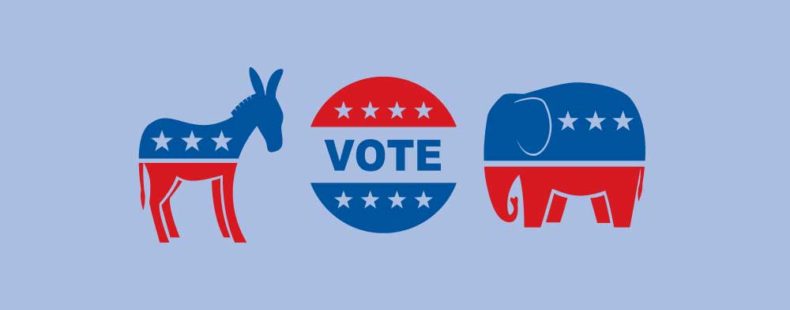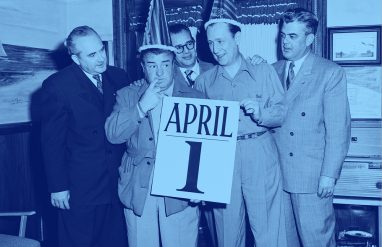WATCH: How Do You Pronounce The Word "Candidate"?
In the US voting system, there are two rounds of voting generally every two and four years. First, a primary or a caucus is held. During those, voters pick a party nominee. For example, in a Democratic primary, voters (often but not necessarily registered as Democrats) would pick among Democratic candidates for an office. The winner of that election then goes on to run in the general election against the nominees of the other parties.
But, what is the difference between a primary and a caucus? Why do some states have one but not the other? If you’re confused on this point, you’re not alone. But we’ve got you covered in this electoral (and lexical) rundown.
What is a caucus?
A caucus is “a meeting of party leaders or party members to select candidates, elect convention delegates, and establish the party’s policy position on specific issues.” The word can also be a verb for meeting in this way (e.g., the Republicans caucused).
The origin of the word caucus is unknown. Some claim there is a root in a Latin word for a kind of drinking vessel (the, um, implication apparently being that these party leaders really liked to drink). Another often cited—though much less probable—origin is that caucus comes from a Virginian Algonquian word for “adviser.”
Whatever the origin, caucuses have long been a part of the American political system. In fact, caucuses are older than primaries—and even the US as a country. Caucuses date back to at least the mid-1700s. One early influential caucus was Boston’s Caucus Club (in modern spelling), memorably described like a smoke-filled room by John Adams and once led by Samuel Adams.
Between 1796–1824, party members in Congress chose their nominees for president and vice president in caucuses. State legislators did the same for governors and their lieutenants. These nominating caucuses were different from modern ones because they were closed to the general public—which prompted backlash that eventually led to more open conventions, primaries, and caucuses to voters in states.
Who uses caucuses?
Since the 1970s, most state parties have adopted primaries, but a minority still use a caucus system, with 10 states switching to primaries since 2016. Six states still use caucuses (or a form of them): Maine, Kansas, Nevada, North Dakota, Wyoming, and, most prominently, Iowa.
It gets more complicated, though, as some states may mix primaries and caucuses, using them for different parts of the voting system (such as caucusing only to pick delegates for a convention) or different parties using different systems (in Kentucky, Republicans use caucuses but Democrats use primaries).
Today, state party caucuses are open to anyone who is a member of the party and registered to vote. These members meet to decide on who they will recommend for nomination, ultimately at their party’s convention. They also discuss the party platform and organize election volunteers.
Caucuses are very different from primaries because they require that voters go to a meeting to participate in the nominating process. And this means caucuses can get pretty lively at local precincts. In Iowa, voters literally try to persuade each other in small groups.
The Iowa caucuses are particularly important in the presidential nominating process. Held in early February, the Iowa caucuses are the first nominating votes in the country for presidential candidates. This is somewhat controversial because some feel Iowa is not representative of the majority of the country. People who support the Iowa caucuses going first argue, however, that it is necessary for candidates to have an incentive to come to and support causes important for this relatively small state.
Election caucuses are losing ground. But members of Congress still form their own groups, also called caucuses, to discuss and promote issues they feel are important, such as the Congressional Black Caucus (made up of Black members of Congress) and the Freedom Caucus, associated with the Tea Party. Legislators can also be said to caucus, or meet more generally, to debate particular issues. These caucuses are not related to elections, but instead are part of the legislating process.
What are primaries?
A primary is “a preliminary election in which voters of each party nominate candidates for office.” A voter goes to polls and casts their ballot for who they want to be the candidate for their party in the general election. The word ultimately comes from the Latin primus, meaning “first,” a reference to the order it takes in the election process—it comes first, before the general.
During the Progressive Era in the late 1800s and early 1900s in the United States, there was a movement to increase participation of voters in the party nomination process. Supporters believed that having a more transparent, public voting process for the nominee would be less corrupt than the caucus system. And so the primary system began to be adopted.
Today, most states use primaries to decide on candidates. Like caucuses, primaries are used to decide on the candidates for local, state, and federal offices.
What are the different types of primaries?
Many states, from New Hampshire to Texas, have what are called open primaries. That means that voters can vote for the nominee of any party, regardless of whether they are registered with that party. For instance, a Republican in Texas could vote for the Democratic presidential nominee. Other states, such as Pennsylvania, have closed primaries. This means that only voters registered with the party can vote for the party nominee.
Washington and California have what are variously known as jungle primaries, top-two primaries, or nonpartisan blanket primaries. In this system, the ballot has all the candidates on it, not separated by party. The top two vote-getters in the primary run against each other in the general, regardless of what party they are from.
Yet other states have partially open primaries, partially closed primaries, or other systems similar to jungle primaries where candidates all run on the same ticket regardless of party.
During presidential elections, the first primary is in New Hampshire. In recent years held in early February or late January, the New Hampshire primary, like the Iowa caucus, is often viewed as a way to ensure that smaller states get attention during the presidential campaign.
The primaries held on Super Tuesday (typically in March) are also considered very important. On Super Tuesday, a lot of primaries or caucuses for the presidential election are held across the states, often over 20 of them. A candidate who wins the early primaries and Super Tuesday is in great shape going to the nominating convention.
Still not a direct process …
Primaries and caucuses are sometimes criticized for encouraging the parties to elect candidates with more radical positions than those that are held by general voters. In fact, primary has also become a verb, meaning “to challenge or oppose (the incumbent) in a primary election, usually for strong ideological reasons,” used in constructions like the incumbent was primaried by a more liberal challenger.
Turnout is typically low for these early electoral contests, which allows small numbers of voters to have an outsized influence. Active, engaged members of the party might vote for someone whose policy positions are more extreme than what less engaged general election voters may want in a candidate. In California and Washington, the jungle primary method was adopted precisely as a way to give more moderate candidates a chance in the state electoral process.
What happens after presidential primaries and caucuses?
Despite the attempts to make the presidential nomination a more direct process in various ways over the course of US democracy, it’s still technically an indirect electoral system. The preferences of the voters are taken into account via caucuses and primaries. Then, each party holds a national convention.
During the convention, delegates representing the will of these voters from each state vote for a presidential nominee. Since the 1970s, the candidate who wins the most votes in the primaries and caucuses wins their party’s nomination.
Once the presidential nominees are named by each party, these candidates then go on to run in the presidential general election. This election is held every four years on the first Tuesday in November: Election Day.
Democracy is messy, as the primary and caucus systems make clear. However, the more people participate, the better it reflects the will of the people. If you’re not sure when your state’s primary or caucus is held or how to participate, you can visit your state’s Secretary of State website to find out.
Want more fun word facts to make you sound (and feel) smarter? Sign up for more Dictionary.com right in your inbox.














